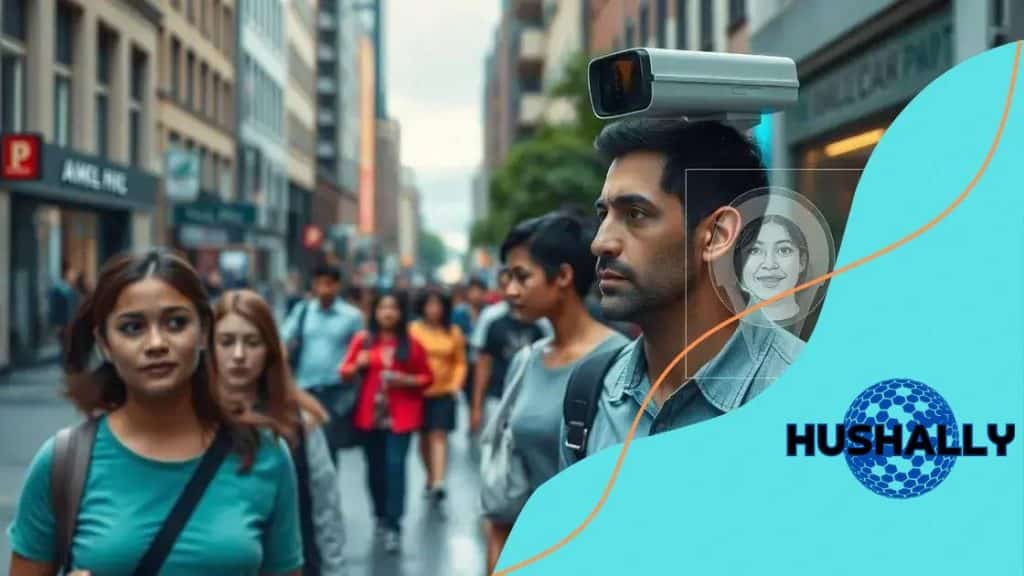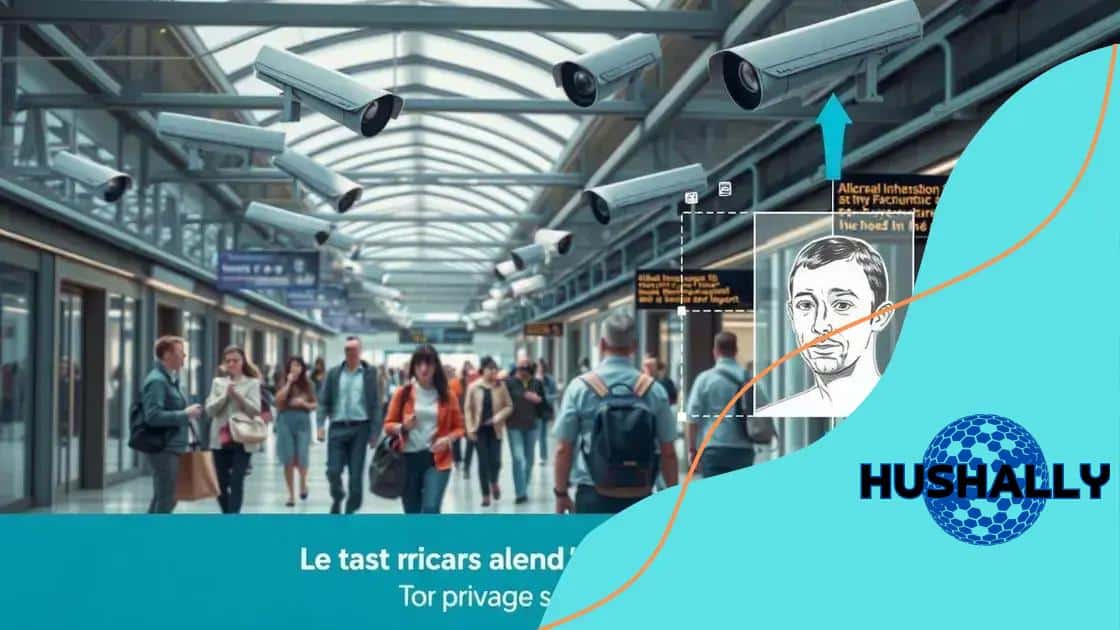The role of facial recognition in enhancing public safety

The role of facial recognition in enhancing public safety involves improving crime prevention and law enforcement efficiency while raising critical privacy and ethical concerns that must be addressed through regulations.
The role of facial recognition in enhancing public safety is increasingly important. Have you ever wondered how technology can help prevent crime and ensure safety in public spaces? Let’s delve into this topic.
Understanding facial recognition technology
Understanding facial recognition technology involves grasping how this advanced system works and its implications for society. With the increase in crime rates, technology has stepped in to provide solutions. One such solution is facial recognition, which is becoming common in various sectors.
How It Works
Facial recognition technology analyzes facial features from images or video. It uses algorithms to map facial landmarks and then creates a digital signature. This signature is compared against a database of known faces, making it easier to identify individuals quickly.
Key Elements of Facial Recognition
- Algorithms: These are processes that help analyze facial features.
- Databases: Large collections of facial images that the system checks against.
- Video Surveillance: Cameras that capture images in real-time for immediate processing.
- Privacy Concerns: Issues surrounding the consent and storage of personal data.
As more organizations adopt this technology, its applications continue to grow. For example, law enforcement agencies use facial recognition to identify suspects swiftly. This not only aids in resolving cases faster but also helps prevent potential crimes.
However, the use of this technology raises several questions about privacy and ethical considerations. People wonder how their data is being used and who has access to it. These concerns highlight the need for regulations surrounding facial recognition technology.
With advancements in machine learning, systems are becoming more accurate and efficient. This means that the chances of misidentification are decreasing, which is vital in sensitive situations. Additionally, as technology evolves, so does its implementation in different fields like retail and security, where it helps enhance customer experiences and safety.
The landscape of public safety is changing, and facial recognition technology is at the forefront of these changes. As society continues to embrace these innovations, understanding how facial recognition works is crucial for informed discussions on its benefits and drawbacks.
Benefits of facial recognition for law enforcement
Benefits of facial recognition for law enforcement are significant and varied. This innovative technology is increasingly seen as a valuable tool for police and security agencies. It enhances their ability to identify suspects quickly, improving overall public safety.
Rapid Identification
Facial recognition enables law enforcement to identify individuals in real-time. When there’s a crime, officers can analyze footage from cameras and match faces against databases. This instant identification can lead to faster arrests.
Key Advantages
- Prevention of Crime: By using facial recognition, law enforcement can spot known offenders in crowded areas, deterring criminal activity.
- Efficient Resource Deployment: This technology allows officers to prioritize their efforts more effectively by focusing on high-risk areas.
- Data Accuracy: Advanced algorithms improve identification precision, reducing the chances of misidentifying innocent people.
- Support for Investigations: Facial recognition can provide critical leads in ongoing investigations, helping to solve cases faster.
Moreover, agencies can better allocate resources by understanding where and when crimes are likely to occur. This proactive approach not only enhances public safety but also builds community trust. As people see law enforcement using technology effectively, they may feel safer and more secure.
The use of facial recognition also aids in missing person cases and child abductions. Law enforcement agencies can quickly scan through images to locate individuals who have disappeared. This capability is crucial in saving lives and ensuring safety within communities.
As technology improves, facial recognition will likely play an even more vital role in maintaining public safety. However, it is essential to balance these benefits with ethical considerations regarding privacy and data security. Effective regulations will be critical in ensuring this technology is used responsibly.
Privacy concerns surrounding facial recognition

Privacy concerns surrounding facial recognition are significant as technology becomes more integrated into our daily lives. As the use of this technology increases, so do the worries about how personal data is collected, stored, and used.
The Nature of Privacy Risks
One major concern is the potential for surveillance. With cameras everywhere, people may feel they’re constantly being watched. This can lead to a chilling effect on personal freedom, where individuals may change their behavior if they think they are under surveillance.
Key Issues
- Data Security: How secure is the information collected? Data breaches can expose sensitive information.
- Lack of Consent: Many individuals do not realize when their images are being captured or used by law enforcement.
- Bias in Algorithms: Facial recognition systems can misidentify people, especially those from minority groups.
- Potential Abuse: There is a risk that authorities may misuse facial recognition technology for tracking or targeting individuals without justification.
The rise of facial recognition technology raises questions about consent and the ethical implications. Many people are unaware that their faces can be scanned and stored without their knowledge. This lack of transparency contributes to fears about government overreach and invasion of privacy.
Moreover, studies have shown that facial recognition algorithms can be biased, leading to higher error rates for certain demographics. This inconsistency can further aggravate social inequalities and highlight the need for careful consideration and oversight.
In response to these concerns, discussions around regulation and protection of personal data are gaining momentum. Many advocate for strict guidelines on how law enforcement uses this technology to ensure that citizens’ rights are protected.
While facial recognition can improve safety, balancing technology use with privacy rights is crucial. As we navigate this complex landscape, ongoing dialogue and strategic measures will be essential to ensure a fair and just application of this technology.
Real-world applications of facial recognition
Real-world applications of facial recognition technology are rapidly expanding across various sectors. This innovation is not only shaping how businesses operate but also enhancing safety and security in communities.
Security and Surveillance
One of the most common uses of facial recognition is in security systems. Many businesses and public places utilize cameras equipped with this technology to monitor activities. This helps detect unauthorized individuals and can act as a deterrent against crime.
Key Use Cases
- Airports: Facial recognition is increasingly used for passenger identification, speeding up check-in and security processes.
- Retail: Stores use facial recognition to analyze customer behavior and personalize marketing efforts.
- Smartphones: Many users unlock their devices with facial recognition for convenience and security.
- Law Enforcement: Police departments employ this technology to identify suspects in real-time during investigations.
Another area where facial recognition is making an impact is healthcare. Hospitals use it to streamline patient check-ins and improve hospital security. Additionally, it helps in tracking patient information, making healthcare delivery more efficient.
Moreover, in the entertainment industry, theme parks and events leverage facial recognition to enhance visitor experiences. By linking facial recognition with customer profiles, they can offer personalized services and expedite entry.
Facial recognition technology also plays a crucial role in enhancing public safety during large events. By monitoring crowds, law enforcement can respond quickly to any suspicious activities or identified threats, potentially preventing incidents before they escalate.
As this technology evolves, the range of its applications continues to grow. However, businesses and agencies using facial recognition must be mindful of privacy concerns and ethical considerations to maintain public trust.
Looking towards the future of public safety
Looking towards the future of public safety involves examining how emerging technologies like facial recognition will shape our communities. As technology evolves, so do the tools available for enhancing security and safety.
Integration of Advanced Technologies
Public safety agencies are beginning to adopt a variety of advanced technologies. These include artificial intelligence (AI) systems, drones, and improved surveillance techniques. By integrating these innovations with facial recognition, authorities can create a more comprehensive approach to security.
Potential Developments
- Predictive Policing: This involves using data analytics and machine learning to anticipate where crimes might occur, helping law enforcement to be proactive rather than reactive.
- Smart Cities: Urban areas are becoming smarter with interconnected systems that use real-time data for better resource allocation and public safety responses.
- Community Engagement: As facial recognition technology becomes more prevalent, agencies will need to enhance public communication to ensure transparency and address privacy concerns.
- Policy and Governance: Future developments will require robust regulations to ensure ethical use of facial recognition and protect citizens’ rights.
The ongoing discussions about the balance between safety and privacy will shape how facial recognition is integrated into public services. Developing clear policies will be crucial to address the ethical implications and build trust within communities. As society embraces these changes, collaboration between technology developers, law enforcement, and the public will be vital.
Moreover, public education on the benefits and limitations of facial recognition technology will help foster understanding and mitigate fears. By explaining how this technology works and the safeguards in place, communities can feel more secure about its use.
The future of public safety is promising as innovations continue to emerge. With a thoughtful approach that prioritizes both safety and civil liberties, technology can play a key role in enhancing public safety while respecting individual rights.
In conclusion, the role of facial recognition technology in enhancing public safety is both promising and challenging. As we move forward, it is essential to balance the benefits of improved security with the need to protect individual privacy. While this technology can help prevent crime and facilitate efficient law enforcement, ongoing discussions about ethics and regulations are crucial. By fostering transparency and trust, communities can embrace these advancements while ensuring that safety measures respect civil liberties.
FAQ – Frequently Asked Questions about Facial Recognition Technology in Public Safety
How does facial recognition technology enhance public safety?
Facial recognition technology helps law enforcement quickly identify suspects, preventing crime and enhancing the security of public spaces.
What are the privacy concerns associated with facial recognition?
Privacy concerns include surveillance without consent, data security risks, and potential biases in the technology that could affect minority groups.
In which areas is facial recognition technology commonly used?
It is commonly used in airports, retail stores, law enforcement, and public events to improve security and efficiency.
What are the future implications of facial recognition technology for communities?
The future implications include better public safety measures, but they also necessitate clear regulations to protect individual privacy and civil liberties.





